Smoked Brisket for Game Day
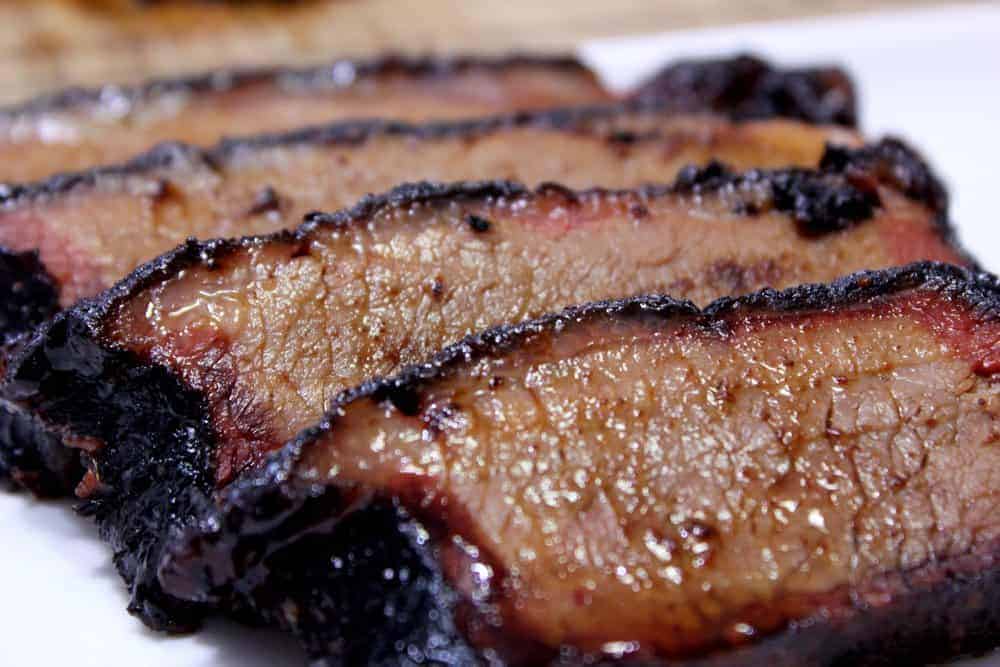
Smoking-Meat.com is supported by its readers. We may earn an affiliate commission at no extra cost to you if you buy through a link on this page.
Read this article without ads
It's no secret that I love smoked brisket in all it's beefy, delicious goodness whether it's sliced, chopped, or made into burnt ends. I love the stuff.
Smoked brisket is a great game day food, and in this recipe, I'm going to walk you through the process of preparing and cooking a brisket in the smoker so that it comes out a winner.
- Prep Time: 15 minutes
- Cook Time: 16 hours
- Smoker Temp: 240°F (116°C)
- Meat Finish Temp: ~200°F (93°C)
- Recommended Wood: Pecan, Cherry, Hickory (all great options alone or mixed)
- Whole packer brisket (slightly trimmed is ok)
- ¼ cup molasses
- ½ cup Jeff's original rub
- Extra long toothpick
Place the brisket fat cap side down on a cutting board or better yet, down into a large, deep foil pan to help contain the mess.
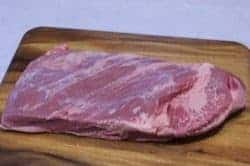
Notice how you can see the strands of the meat and the direction that they run? This is called the grain.
Since we slice across that grain to get the most tender bite, we'll need a way to remember the direction of the grain once it's covered with rub and cooked.
For this reason, it's a good idea to mark this somehow so you'll know how to slice it later.
I sometimes notch the meat, but an even better idea is to simply run an extra long toothpick through it in the same direction that the slices need to be cut. This stays in throughout the cooking process.
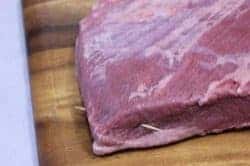
This side will be facing down in the smoker but let's season it up before we flip it over to fat cap up.
I sometimes use mustard, spicy mustard, olive oil, barbecue sauce, etc. to create a sticky surface on the meat so the rub will stick. Rub is no good to anyone if it just simply falls off when you flip it over or when you are placing it on the smoker grate. A sticky surface under the rub fixes this problem.
This time we'll use molasses as it is very sticky, gives it great color when mixed with my original rub and tastes amazing as well.
Pour on some molasses.
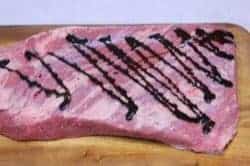
Then use your hands or a cooking brush to spread it out.
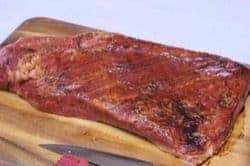
Sprinkle ¼ cup of Jeff's original rub onto the brisket and use your hands to spread it out over the top and sides.
Let it sit for 5 minutes or so before flipping it over.
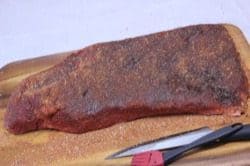
The fatty side of the brisket called the “fat cap” only needs to be about ¼ inch thick. You can trim it down to this thickness using a sharp knife if you want to.
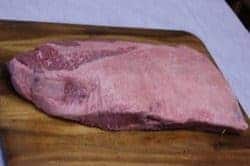
As you can imagine, the smoke and rub does not get through that layer of fat so you might wonder why we leave it on instead of just trimming it all off..
Well, during the cooking process, this fat will begin to melt and as it does, this super tasty juices will flow over the brisket and down the sides sort of self-basting.
Now, let's cut a crosshatch pattern into the fat cap. Try not to cut into the meat but it's not the end of the world if it does happen.
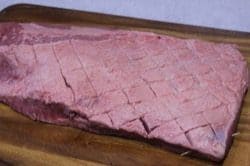
This allows the juices to get trapped a little down next to the meat helping to keep it more moist. It also gives the rub a place to hold on to so the melting fat cap doesn't just wash all of the rub away. I also believe this gives the smoke just a little bit of access to the meat that it wouldn't have on that side otherwise.
Now let's do the molasses thing to the fat cap.
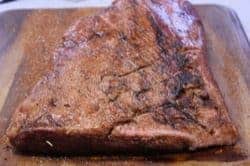
And pour another ¼ cup of Jeff's original rub onto the fat cap and rub it in real good.
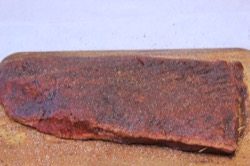
The brisket is now in the correct configuration and is ready for the smoker and you can start dreaming about the delicious smoked brisket you'll soon be enjoying!
Set up your smoker for cooking at 240°F (116°C) using indirect heat. Lower heat is ok if you must but, just know that this means it will take your brisket a little longer to get done.
If your smoker has a water pan, fill it up with water.
When the smoker is ready to cook, place the brisket on the smoker grate fat side up and close the door or lid.
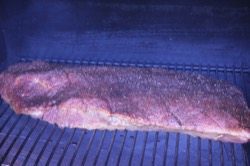
I used a pecan/cherry mix for smoke but any good smoking wood will work fine for smoked brisket.
For large, normal sized packer briskets, you can expect it to take about 5-6 hours to reach 155-160°F which is the point at which the brisket can be wrapped in foil or paper.
I used my orange ThermoPop to get periodic temperature readings for this cook and because it reads in just a few seconds, I can raise the lid, get a reading and close the lid in under 5 seconds. That's lightning speed in the world of instant read thermometers.
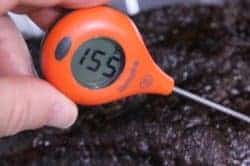
You can also use a leave-in digital probe meat thermometer if you have one. Check out the “Smoke” by ThermoWorks.
Should you wrap the brisket once it reaches 155-160°F?
Wrapping a brisket helps it to get done faster, creates a more tender smoked brisket, and it helps to retain the moisture so it ends up a little more juicy. The down side is that the bark can end up soggy instead of nice and crisp.
Wrapping in paper does help the bark to maintain most of it's crispness and is a great choice for wrapping brisket. I sometimes wrap in paper or foil but often I choose to leave it alone.
You can purchase the food-grade natural brown paper in 18-inch or 30-inch width and it works great for this purpose.
There is also a pink/peach colored paper that some like to use.
This is completely your decision, so if you haven't tried wrapping, you probably should so you can make a good decision on whether to wrap or not wrap on future briskets.
If you do decide to wrap, just simply wrap it in foil or paper making sure it is tightly closed. Place it back in the smoker as quickly as possible in the same configuration as before.
Continue cooking the brisket until it reaches about 200°F (93°C) at which point I start checking it for tenderness using the butter test.
The butter test means that when a brisket is perfectly done, pushing a sharp probe or skewer into it should feel like it's going into soft, room temperature butter.
I put a half-stick of butter on the counter for a couple of hours to soften so I could compare the feel..
I then slid a wooden skewer into the top of the stick of butter before probing the center of the brisket flat. You can do this at home to get a feel for what a done brisket feels like.
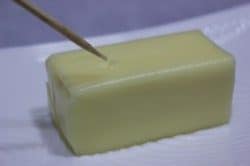
It should go into the smoked brisket with little to no resistance when it is done.
Usually this happens at about 200°F (93°C) but can happen at higher temperatures if your brisket is particularly tough. Feeling the resistance is a great way to learn how to tell when brisket has reached it's sweet spot.
Once the brisket hits this “sweet spot” I recommend removing it from the heat right away.
Before serving the smoked brisket, it needs to be rested for 1.5 to 2 hours in a dry, empty cooler wrapped in a layer of foil during which time, the juices will redistribute throughout the meat and it will end up being more juicy and tender than it would if you skipped this step.
If the brisket isn't already wrapped, place the brisket on a long piece of heavy duty foil.
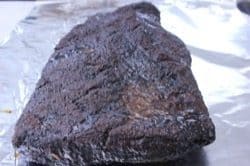
Wrap the foil completely around the brisket..
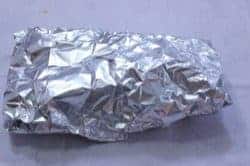
Place the brisket down in the cooler..
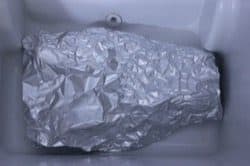
I like to place pillows, towels, etc. on top of the brisket to insulate it while it rests.
Once the brisket is rested, it can be removed from the foil wrapping and sliced up for serving.
Be sure to set aside any juice from the foil or foil pan.
Beautiful mahogany color and juices puddling on top..
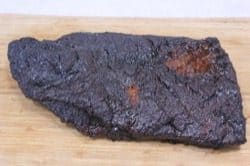
(don't forget to remove the toothpick)
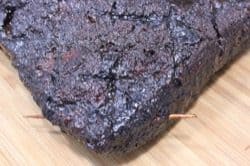
First cut.. and beautiful smoke ring.
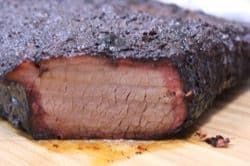
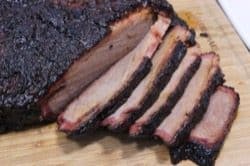
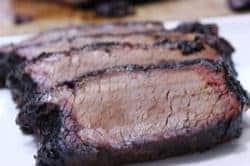
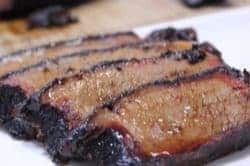
If the brisket slices are not as juicy as you hoped, pour some of the reserved juices from the foil wrap or the pan over the brisket slices just before serving.
Smoked Brisket for Game Day
Ingredients
- 1 Whole packer brisket (slightly trimmed is ok)
- ¼ cup Molasses
- ½ cup Jeff's original rub
- 1 Extra long toothpick
Instructions
- Place brisket fat cap down inside of a large foil pan.
- Coat the top of the brisket with molasses then sprinkle ¼ cup of Jeff's original rub onto the top and sides of the brisket.
- Give the rub a couple of minutes to stick then flip the brisket over to fat cap up.
- Use a sharp knife to score the fat cap down to the meat using a crosshatch pattern with about 1-inch intervals.
- Coat the scored fat cap of the brisket with molasses then pour ¼ cup of Jeff's original rub and rub it in. The idea is for the molasses and rub to get down into the score marks in the fat cap.
- The brisket is now ready to cook in the smoker.
- Set up your smoker for cooking at 240°F (116°C) with indirect heat using a mix of pecan and cherry wood for smoke or whatever smoking wood you have available.
- Let the brisket smoke cook for about 5 hours or until it reaches 160°F (71°C) in the thickest part of the flat area.
- At this point you can wrap the brisket with foil or food-grade natural brown (or pink) paper and continue the cooking process in the smoker.
- The brisket is done when it reaches about 200°F (93°C). You can test the brisket for perfect tenderness by inserting a probe or skewer into the flat area. It should have very little resistance and feel like it's going into room temperature butter.
- Once done, remove the brisket from the heat.
- It should be wrapped in foil at this point and allowed to rest for 1.5 to 2 hours in a empty, dry cooler.
- After resting, remove the brisket from the foil and slice across the grain into pencil-thick pieces.
- Enjoy!


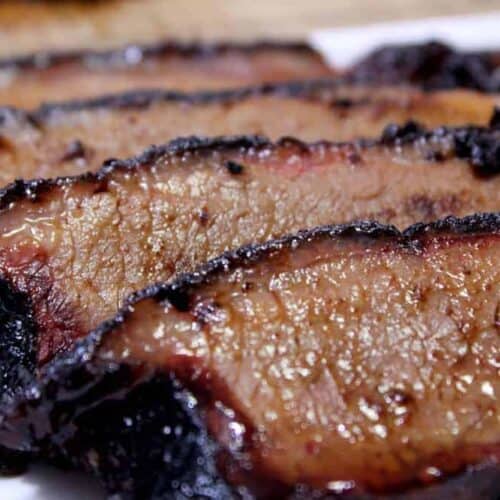
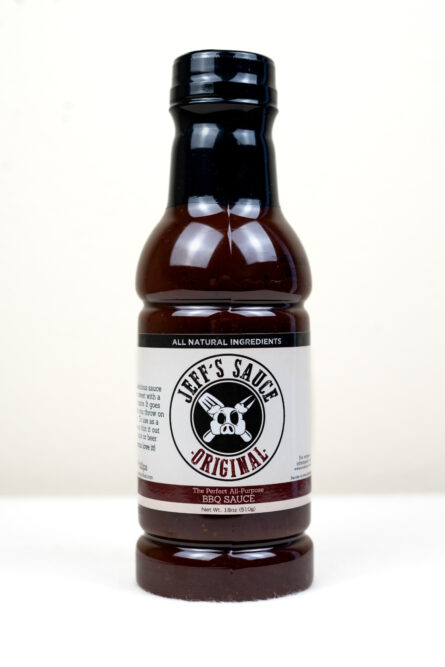
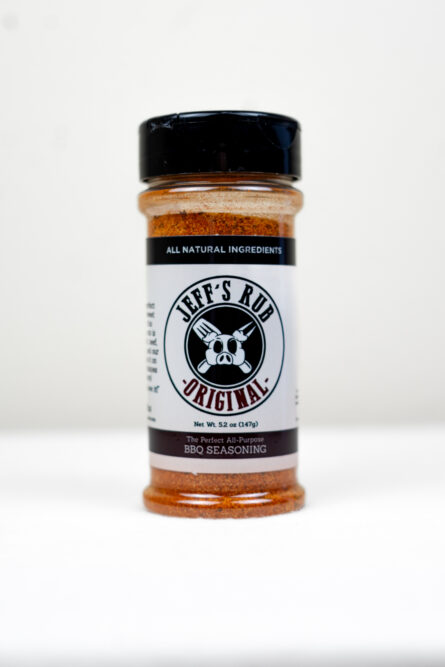
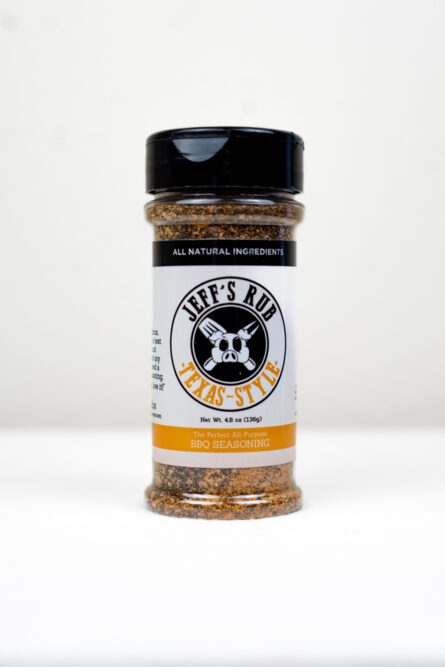
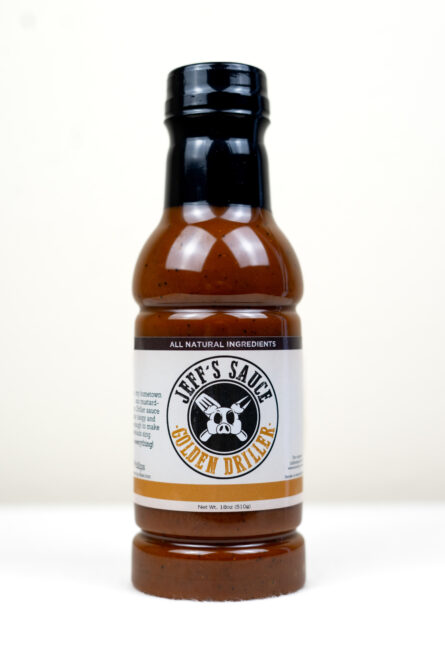
Don’t have a cooler rest it your oven
As always Jeff, this is a great presentation and recipe. Thank you for incredible information regarding the smoking of meat. Keep up the great work. We did a brisket for our summer bridge club windup. Tremendous!!
Hi Jeff have you ever used molasses on a pork butt ? Thank You Very Much !! Stephen
Did you leave in pan
I often do cook them in the pan the entire time or on a pan with a rack and they do really well. This one was just placed on the grate fat cap up the entire time.
For my husbands 70th birthday we smoked a brisket following your instructions. This was our first brisket. We had cut it in half- down the middle separating the point and flat. We smoked it for 11 hours at 225. Wrapped it for the rest of the stall. 14 hours total. Your best advice was not to get hung up on the time or temperature of the meat. It’s done when a probe slides in like warm butter. The flat was done at 205 degrees, the point at 200. For this reason I am very happy we separated the two. We used molasses and our rub. the color of the meat was beautiful not to mention a smoke ring that was over 1/4 inch! We rested it in a cooler for 2 hours. It was very juicy and tender when we cut it. Not to mention delicious. Our guests raved about it. It was such a relief that we didn’t ruin 50.00 worth of meat! Wish I could post a picture! Thanks to you for all your advice! We enjoy your recipes and newsletter.
It would be helpful if you included the weight of the brisket or cooking times per pound.
Thanks!
I have been searching for the elusive juicy and tasty brisket since first tasing it in Texas several years ago. I followed the pre-cooking instructions and put molasses and rub on the brisket for 6 hours, then cooked the packer brisket (Costco) overnight this past Saturday, at 200-225 deg.f. in our Big Green Egg until the brisket reached 192 deg. f., which was about 16 hours, removed from the BGE and wrapped it in foil, towels and into a cooler for about 3 hours. It was good but a little dry, not as juicy as I had expected. Too long a cook maybe? Too low? I’ve been following Jeff’s smoker recipes since getting the BGE.
Don’t cook for 16 hrs smoker @250 9 hrs completely done and moist
Keep in mind that every brisket is different.. “cook to TEMPERATURE not to time” is my mantra and will remain so. Doing this, you can estimate the time all you like, but ultimately it’s not done until it’s tender and has reached the correct temperature. The brisket for this recipe took 16 hours.. others will take less or more depending on the temperature you maintain, the type of smoker, how often you open the door, how cold the meat is when it goes into the smoker and even weather variables such as wind.
I have a REC TEC no water pan. Can I put a pan in the bottom and fill with water? Wil the temp be lower in the grill?
You can definitely use a water pan but I don’t think it’s really necessary in pellet grills. I have used a water pan in other pellet grills (not the REC-TEC) to try it out and I did not notice that it made any impact on the actual temperature, the cooking process or the finished product.
Do u smoke for the entire 5/6 hours? Heavy or thin smoke? How do u carve or serve the nose portion?
Question – When you say “the brisket is in the correct configuration for the smoker” is that fat cap up or down? Hard to tell from the picture. I know that is an age old fight, but since it is your recipe I would like to know your opinion. Also, do you have any adjustments for high altitude? I live at 9100 feet and have had a much harder time getting briskets to temp at this altitude vs at closer to sea level.
Yes. I like to keep this one fat cap up for the entire time from start to finish. This is due to the fact that I made the cuts into the fat cap which allows the juices and the rub to pool on top and hang on a little better.
This is my favorite brisket recipe. I have a question – I don’t get as much of a smoke ring with this recipe. Is it possible that the molasses reduces smoke penetration?
Question: How do you maintain the temp on the thin end so that does not overcook? I have probe thermometers in three locations, but the thinner ens temperature increases much faster.
I thought the same thing when I first started cooking brisket. It will even out.
I have been using either a specific Texas rub, or cabelas brisket rub each time I smoke a brisket. I cover in regular yellow mustard, then rub and wrap in plastic for 8-12 hours in the fridge. I set my pellet smoker to high smoke, 225 degrees. I usually double wrap at 160, but as I sit here at 5am this morning, with a 13 pounder a little over 5 hours in, i am creeping on 160. I’ve always ended up with a soggy bark. So today, I’m going unwrapped. I’ve always heard that leaving unwrapped causes the meat to stall around 165. I guess I’ll put that to the test today! I also rest it up to 5 hours in a foil covered pan with old bathroom “smoker towels”. Hoping for a good, crispy turn out for a tailgate this afternoon!
So how did it run out? I wonder if the soggy bark comes back from wrapping it in plastic for 5 hours.
Hey Jeff, Great writeup on the brisket. A couple of comments on my own experience. I do mine similarly to what you have written up but I generally hang it in a pit barrel and you will cook it much faster and still tender and delicious that way When I take it out of the smoker at 200° and wrap it in tinfoil as you do I tent the tinfoil and add 1/2 cup of beef broth to the top of the brisket prior to wrapping up the foil. I then wrap the tinfoil in a beach towel and put into a dry clean cooler as you do I believe that the half cup of beef broth adds to the moistness of the cooked brisket. Again thanks for the great writeup I really enjoy your site
Same happens to me that the recipies all say to smoke for a super long time. Since i live in AZ and have dry heat i have noticed its 1/2 the time everyone else takes. If i cooked a brisket for 16 hrs it would turn to dust
How long do you smoke a 6lb brisket
Until the brisket is 200-205 degrees and is probe tender. I can see this taking anywhere from 6-9 hours – but temo is what you want – not time
Is there a brinig process for briskets to get a certain flavor or spice into the meat?
We usually do not brine brisket. If you want more flavor on the inside you can always inject with some doctored up beef broth. I don’t have a specific recipe but I start with beef broth and add a little Worcestershire sauce, soy sauce, hot sauce, etc. Whatever sounds good and I just taste it as I go. There may be some specific beef injection recipes at the forum. http://SmokingMeatForums.com
I use a leave in Thermometer, and fill water pan with a mix of apple juice and beer. I slice fat cap in cross hatch pattern , I rub it down with A heavy grainy Dijon mustard and use only kosher salt and fresh ground black, white, and red peppercorn medley on both sides. Put it in the smoker fat cap up. I smoke it at 225 deg. using mesquite ( I keep the smoke going heavy the whole time) ,until it reaches 145 deg. I take it out wrap it in butchers paper and put it back in and cook without smoke until it’s at 165 deg. I take it out and put in a small yeti cooler and throw a couple towels over it and close the lid. I let it set for 1-1/2 hr. Take it out and it’s ready to slice and eat. So tender and juicy. Depending on the size of the brisket it usually takes 5-6 hrs in the smoker…
Would the temp and cook times of this recipe be right if I’m using a pellet smoker/grill with no water pan?
Thanks
Question — when the brisket gets wrapped either in butcher paper or foil and put back in the smoker, do I continue to add wood and keep “smoking” it the rest of the time?
Because it’s wrapped, the smoke will not be able to get to the meat or at least at a very reduced level. You can stop adding wood for smoke once the meat is wrapped and just maintain the heat.
My experience with flats has been that it takes about 1 hour per pound at 225-235 using the water pan in my Humphreys smoker. Cook to 195 degrees and control the cook with a BBQ GURU. Stays moist with just enough char on the bottom to offset the moist bark a little.
Two factoids:
(1) I use Pepsi-Cola syrup instead of molasses. Great taste and no sulfur taint.
(2) I’ve found that the best way to keep frozen things frozen and hot things hot in a cooler is to wrap it in 3-4 layers of bubble wrap. Obviously, if it is a hot piece of meat, you still have to wrap it in foil first.
Is the cook time 5-6 or 16 hours? In the recipe, it says 16 hours For a flat, I’d think 5-6 hours is enough
To have the brisket(16.6lbs.) done for Thanksgiving ( or game time) I started the brisket at 4-5pm and smoked on my Meadow Creek smoker at 230 degrees for 6 hours (temp was 165). Then I wrapped it in butchers paper and put it in the oven at 215 degrees and had the Thermapen “Smoke” probe in it. Kept the monitor at bedside. By 9:30 next morning was up to 200 degrees and then put it in Yeti cooler. Was still nice and warm that afternoon and perfect. Great smoke ring and flavor and tender.
This seems like the best way to not have to be up all night long. Do you have to wrap at 165 when you put it in the oven? I’m wondering if skipping the wrapping will help the bark not get soft and whether or not this will affect moistness.
Did my first packer brisket and it came out pretty dang good.
Did a couple of things that were a bit different than this recipe.
1. After putting the rub on the meat I covered it in plastic wrap and put it in the refrig overnight…..don’t know if this is good or not!
2. I made a mop of apple juice, apple cider vinegar, Worcestershire sauce and veg oil. Applied this about once an hour with a spray bottle……did This cause I don’t have a water pan.
3. And at 165 degrees, I wrapped the meat in aluminum foil and put back on smoker till 200 degrees.
The meat came out super tender but the bark got too soft.
Would the bark get crispier if I take the meat out of the foil around 190 degrees and finish unwrapped?
Oh, and I ended up with a good amount of the mop…..any idea how long it can be kept in the refrig……I’d use it next time I smoke ribs.
Ron, try butcher paper instead of foil. It will help keep the bark a little more crustier. Or you could skip wrapping all together.
I have tried to do several brisket flats. Every time I followi these directions have come out over done. Please help!
I just used this recipe on a full packer this weekend and mine was very dry too. It went for 16 hours in my GMG Daniel Boone at 225. The bottom cramelized and burned. I ended up throwing away 1 1/2 pounds of meat. Not sure what I did wrong.
Did you have any water in the smoker. I did the same thing and found a water pan works
Jeff,
I know temp is the key. However, it would be helpful if you would give us a rule of thumb calculation for cooking the meat. Parker trim brisket can run from 8-14 lbs. when you tell us you smoked it for 16 hours, you could tell us the size of the brisket you were smoking, smoker temp and finished meat temp and it would help in knowing when to start smoking for a desired time to serve. Hope this makes sense.